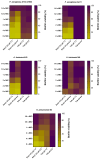The pH-Insensitive Antimicrobial and Antibiofilm Activities of the Frog Skin Derived Peptide Esc(1-21): Promising Features for Novel Anti-Infective Drugs
- PMID: 39200001
- PMCID: PMC11350779
- DOI: 10.3390/antibiotics13080701
The pH-Insensitive Antimicrobial and Antibiofilm Activities of the Frog Skin Derived Peptide Esc(1-21): Promising Features for Novel Anti-Infective Drugs
Abstract
The number of antibiotic-resistant microbial infections is dramatically increasing, while the discovery of new antibiotics is significantly declining. Furthermore, the activity of antibiotics is negatively influenced by the ability of bacteria to form sessile communities, called biofilms, and by the microenvironment of the infection, characterized by an acidic pH, especially in the lungs of patients suffering from cystic fibrosis (CF). Antimicrobial peptides represent interesting alternatives to conventional antibiotics, and with expanding properties. Here, we explored the effects of an acidic pH on the antimicrobial and antibiofilm activities of the AMP Esc(1-21) and we found that it slightly lost activity (from 2- to 4-fold) against the planktonic form of a panel of Gram-negative bacteria, with respect to a ≥ 32-fold of traditional antibiotics. Furthermore, it retained its activity against the sessile form of these bacteria grown in media with a neutral pH, and showed similar or higher effectiveness against the biofilm form of bacteria grown in acidic media, simulating a CF-like acidic microenvironment, compared to physiological conditions.
Keywords: Gram-negative bacteria; acidic pH; antibiotics; antimicrobial peptides; biofilm; cystic fibrosis; infections.
Conflict of interest statement
The authors declare no conflicts of interest.
Figures







References
-
- Pezzulo A.A., Tang X.X., Hoegger M.J., Abou Alaiwa M.H., Ramachandran S., Moninger T.O., Karp P.H., Wohlford-Lenane C.L., Haagsman H.P., van Eijk M., et al. Reduced airway surface pH impairs bacterial killing in the porcine cystic fibrosis lung. Nature. 2012;487:109–113. doi: 10.1038/nature11130. - DOI - PMC - PubMed
Grants and funding
- Project FFC#4/2022. Delegazione FFC Ricerca di Roma e della Franciacorta e Val Camonica/Fondazione Italiana per la Ricerca sulla Fibrosi Cistica
- Project no. PE00000007, INF-ACT/NextGeneration EU-MUR PNRR Extended Partnership initiative on Emerging Infectious Diseases
- RP122181619F624E/Sapienza University of Rome
- R01 AI176537/AI/NIAID NIH HHS/United States
- RM1221815DABA9B4/Sapienza University of Rome
LinkOut - more resources
Full Text Sources
Molecular Biology Databases

